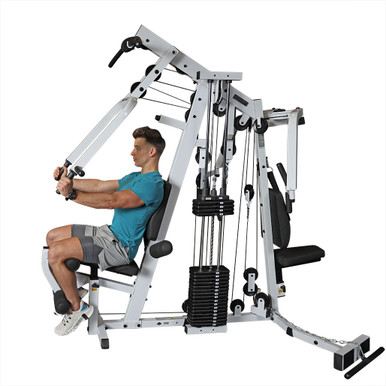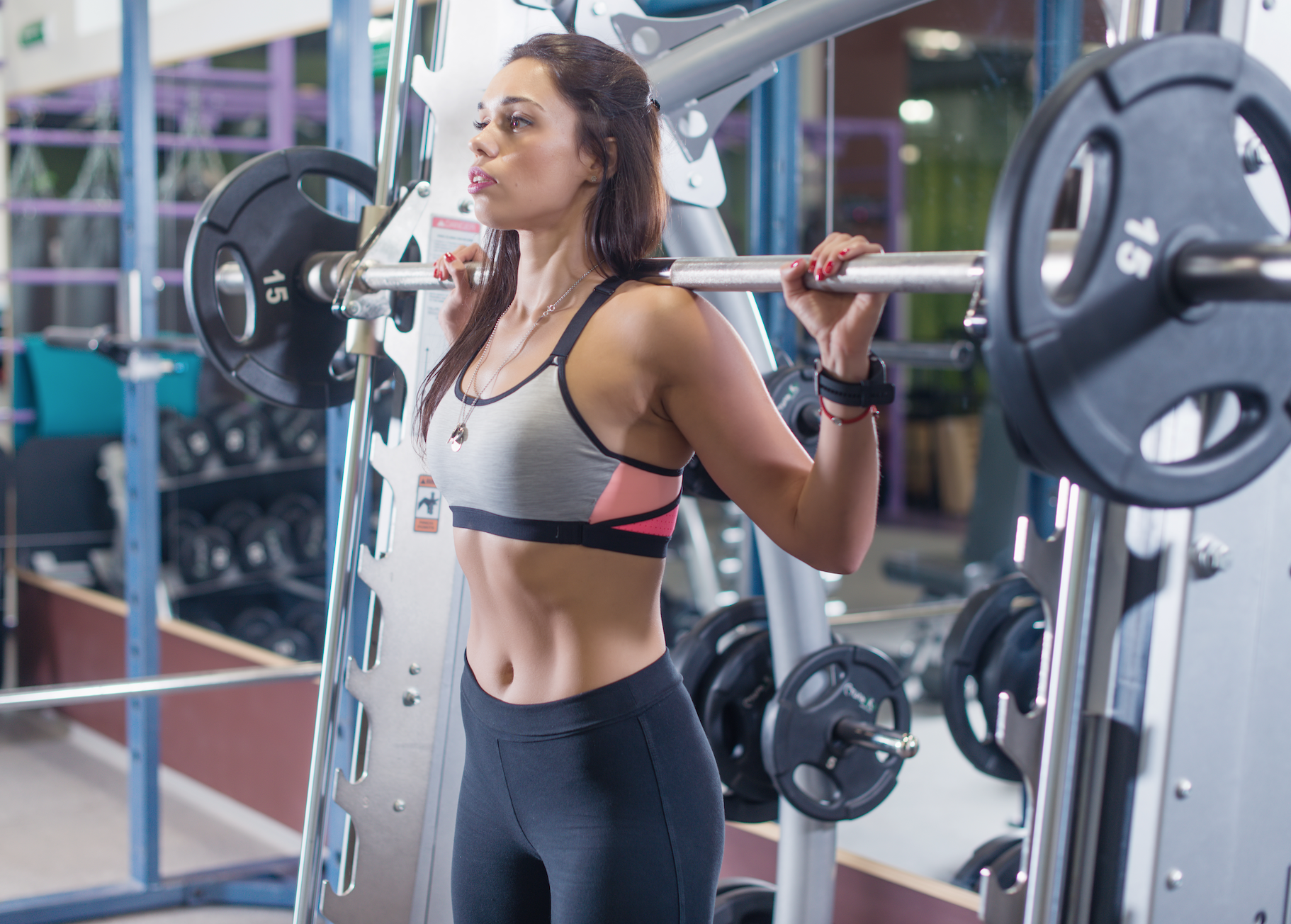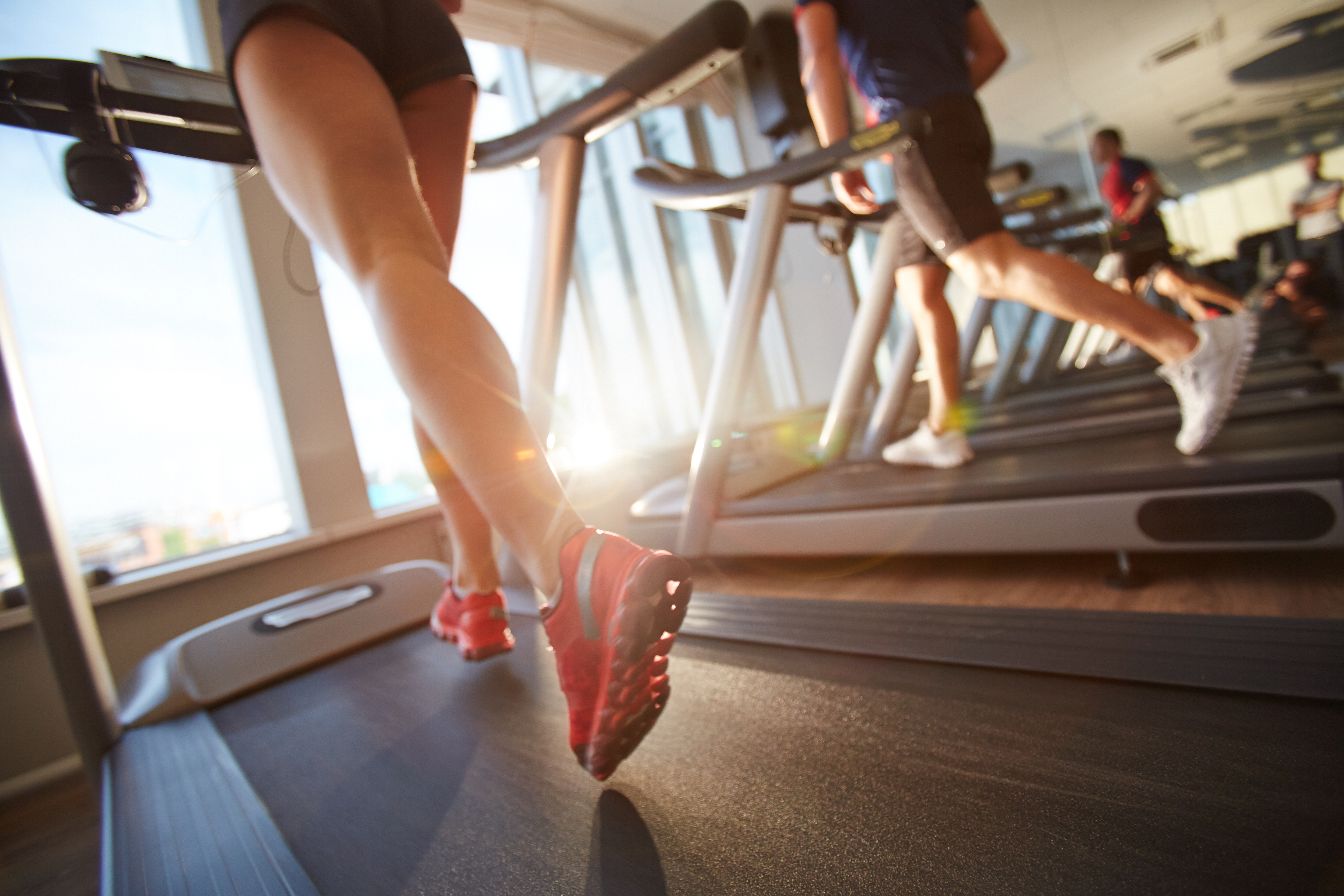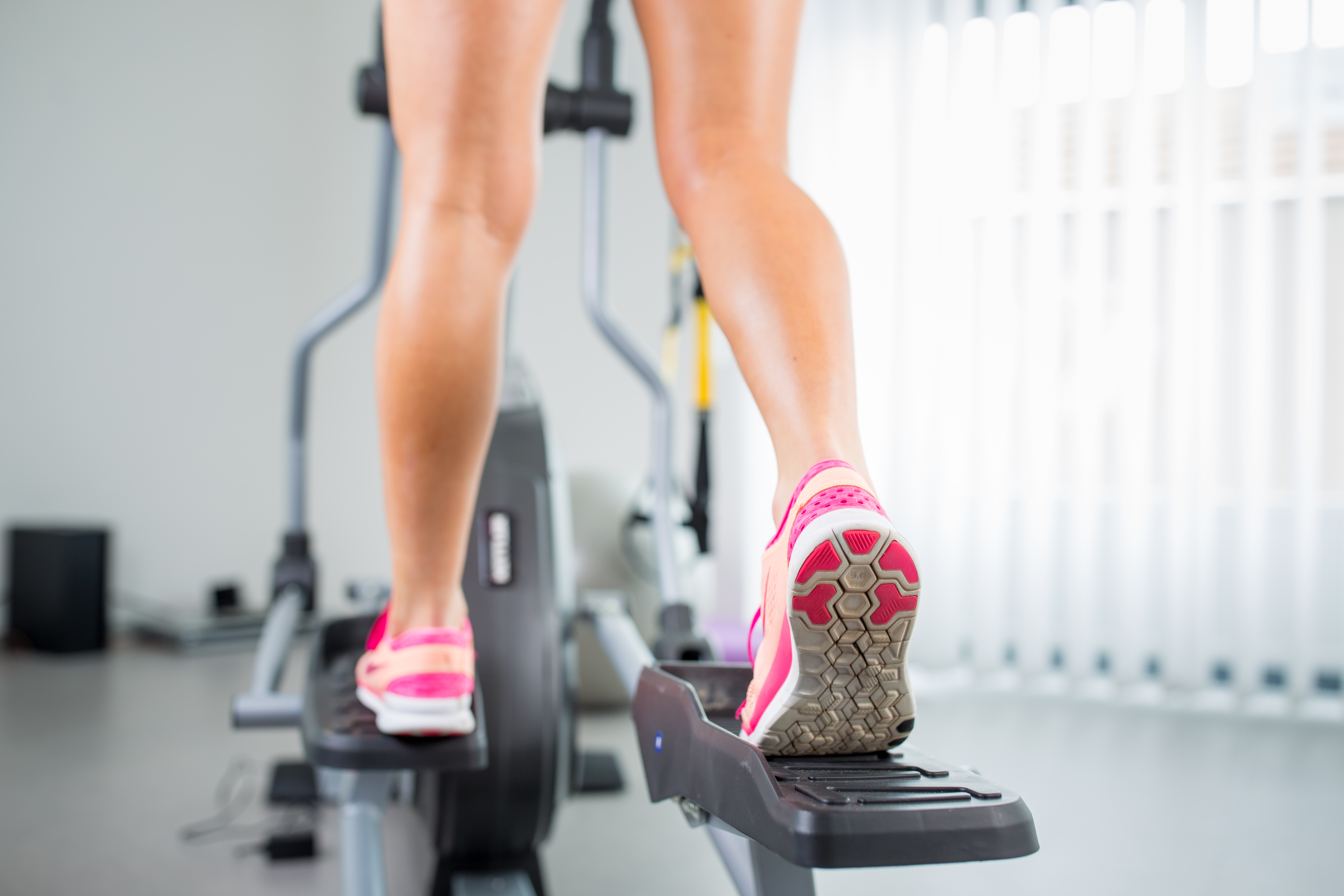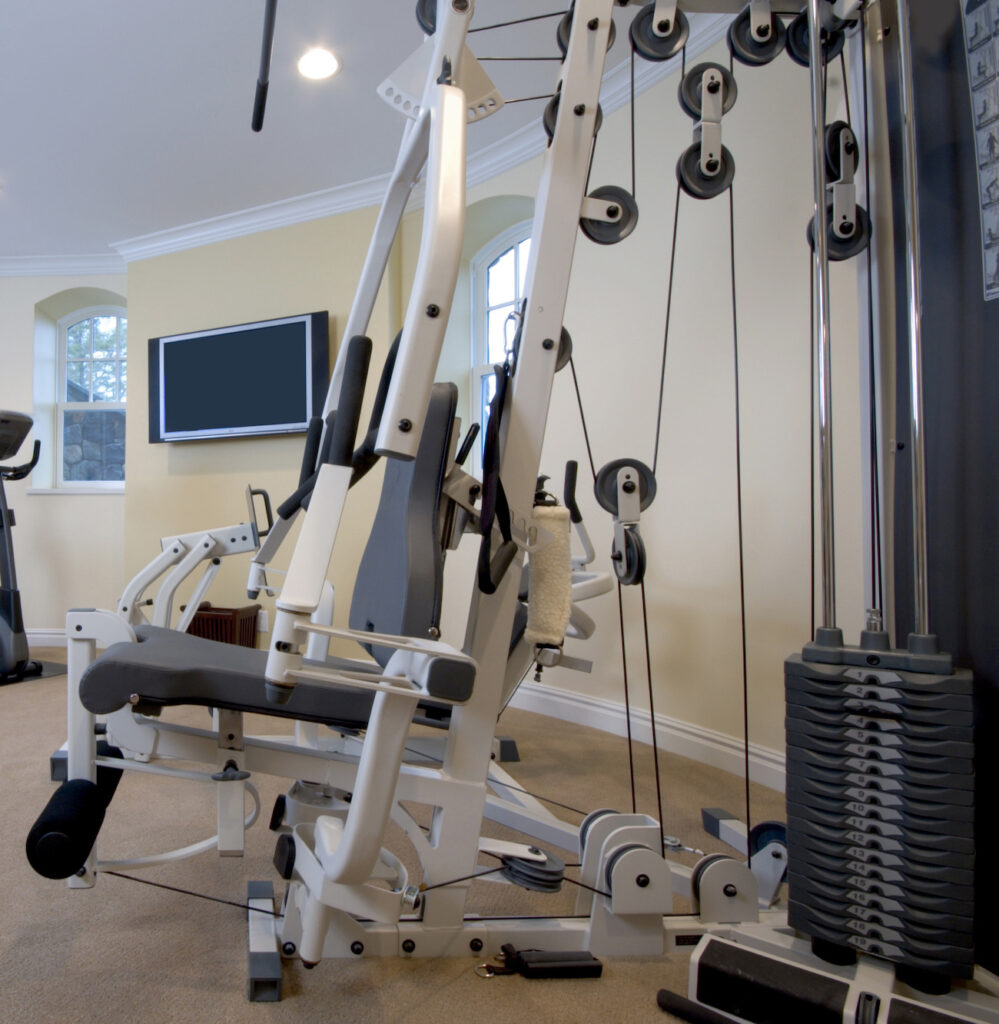
When it comes to home gyms, the single stack weight system is about as classic as you can get.
Not only do these handy devices give you the ability to perform tons of different strength training moves from a single machine, but they usually come with a compact footprint as well.
This makes them a great choice for home gyms because you don’t have to buy a bunch of separate benches, bars, and plates to get the job done.
Which can certainly take it easier on your wallet.
Single stack gyms are also great because they’re safe to use- with the weight stack safely behind you, there’s really no threat of being smooshed by crashing weights if you lose control.
Nowadays, there are a ton of these home gyms to choose from, so you’ve got plenty of opportunity to find exactly what you’re looking for.
That said, having so many options can also make it harder to tell the difference between the quality gyms and the not-so-quality ones.
Luckily, if you’re reading this, you’ve come to the right place.
In this guide, I’ll go over everything you should know when looking for a single stack home gym system. I’ll also provide my top picks for the year, based on the criteria we discuss in the buyers guide.
After reading, you’ll know everything you need to in order to find the right single stack gym for your home gym.
| Weight Stack | Stations | Warranty | |
|---|---|---|---|
| #1 Body-Solid G5S | 210 lb | Lat pulldown, press bar, pec fly, leg developer, lower pulley, ab station | Lifetime frame Lifetime parts Lifetime wear items |
| #2 Life Fitness G4 | 160 lb | Lat pulldown, press bar, pec fly, leg developer, lower pulley, ab station | Lifetime frame Lifetime parts 3 year cables & pads |
| #3 Inspire M2 Multi Gym | 160 lb | Lat pulldown, press bar, mid pulley, leg developer, lower pulley | Lifetime frame Lifetime parts |
| #4 Body-Solid EXM2500S | 210 lb | Lat pulldown, press bar, pec fly, leg developer, lower pulley, ab station | Lifetime frame Lifetime parts Lifetime wear items |
| #5 Powerline P2X | 160 lb | Lat pulldown, press bar, functional pulleys, leg developer, lower pulley, ab station | 10 year frame 1 year parts |
| #6 Powerline BSG10X | 160 lb | Lat pulldown, press bar, leg developer, lower pulley, ab station | 10 year frame 1 year parts |
The 6 Best Single Stack Home Gyms 2025
#1 Body-Solid G5S
Body-Solid is a great brand, known primarily for their home gym machines.
This is what they specialize in and they do it quite well.
The G5S is one of their highest-end single stack systems and as such, it’s got a lot to offer.
This home gym comes standard with a 210 lb weight stack, which is a good start for the folks looking for more resistance to work against.
And you can purchase an additional 50 lb for even more resistance if you need it.
The G5S comes with all of the same pulleys and stations you see on a lot of home gym systems: lat pulldown, chest press bar, leg developer, lower pulley.
But unlike most, there’s also an ab station working off the middle pulley system, that can be used for ab crunches, as well as seated tricep extensions.
The press bars on this gym are also adjustable, allowing you to perform incline presses at different angles. You can even perform a standing shoulder press with the G5S, which is pretty awesome.
The press bars also come with multiple grips, allowing for any hand position you might want to use and there are separate pec fly arms as well.
The G5S is also a very heavy-duty gym (so if you decide to purchase, make sure you know exactly where it’s going before assembly).
Fully assembled, it weighs in at 511 lb, which is massive for a single stack machine.
When it comes to the warranty, you can’t beat Body-Solid’s lifetime guarantee on everything from top to bottom- and this includes the grips and pads.
Included with purchase you get the lat pulldown bar, the row bar, the trice/abs straps, and an ankle cuff.
Body-Solid also throws in an exercise DVD and an exercise chart to make sure you have everything you need from day 1.
There are several additional attachments you can buy separately to expand the G5S down the road, including a leg press system and a hip abduction/adduction station.
Overall, the G5S is as high-end as single stack gyms go and it’s guaranteed for life. If you’ve got the budget for it, I don’t think you’ll be disappointed. See full review.
#2 Life Fitness G4 Home Gym
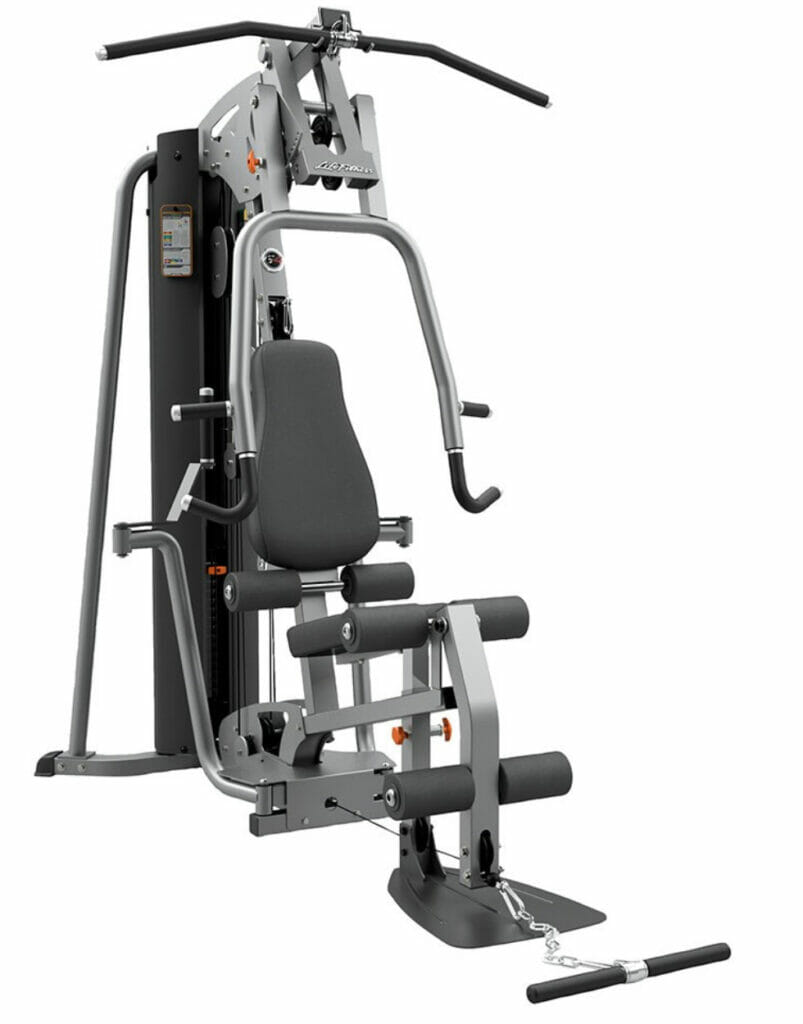
Life Fitness is a brand most of you are probably pretty familiar with.
I mean if you’ve ever been to a commercial gym in the US, odds are you’ve probably used some of their cardio machines.
But even though their most well-known for their commercial lineup, Life Fitness has a pretty extensive collection of residential machines too.
Like their G4 Home Gym.
I like the G4 not only because it’s well-built and smooth acting, but also because it’s priced surprisingly well for such an elite brand.
That said, it’s still priced near the top of the expected budget for home use machines, so if you’re working with a limited budget, the G4 might not be the best option for ya.
This home gym comes standard with a 160 lb stack and all the workout stations you’d expect.
An additional 50 lb of stack can be added for additional cost.
These include the upper lat pulldown, the chest/shoulder press bars, the leg developer, and the lower pulley station that can be used to perform several moves, like seated rows, bicep curls, and upright rows.
The G4 also comes with separate pec fly/rear delt handles for targeting your chest and/or rear delts/rhomboids.
The press arms are adjustable angle, allowing you perform incline press at varying degrees, as well as a shoulder press.
This gym is quite heavy-duty, coming in with an assembled weight of 484 lb and a max weight limit of 300 lb, so no concerns there.
It’s also backed by a lifetime frame and parts guarantee, as well as 3 years on the cables and pads.
When it comes to attachments, the G4 comes with a lat pulldown bar, a row bar, triceps/ab straps, and an ankle cuff, but you can also purchase a leg press attachment separately if you like.
Overall, the G4 is a heavy-duty home gym that’s built to last a lifetime. It has everything you’d expect, but it’ll feel more commercial-like than most.
A perfect example of what a single stack system can be, as long as you have the budget for it. See full review.
#3 Inspire M2 Multi Gym
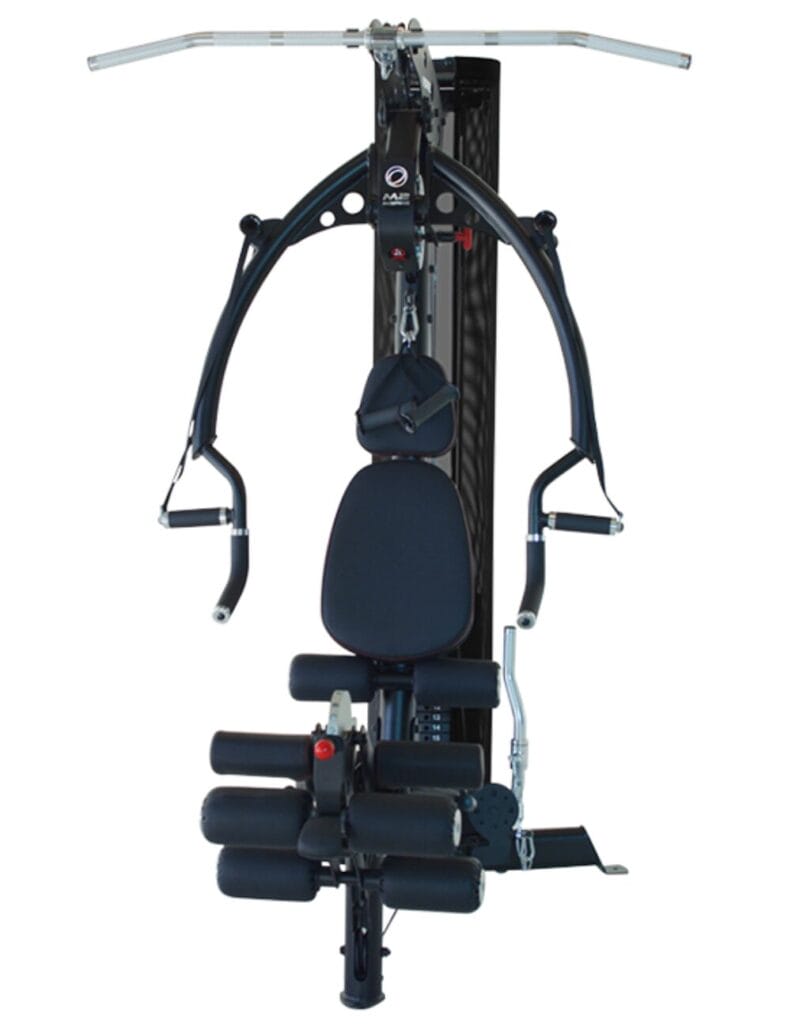
Inspire Fitness may not always get a ton of attention, but their home gyms are casually some of the best in the world.
They’re probably most-known for their impressive functional trainers, but their single stack gyms are equally as impressive.
Inspire offers a few gyms in this category, but I think their M2 probably has the best features to price ratio, making it a great buy.
The M2 only comes with a 160 lb stack, so it’s not packing as much resistance as some gyms, but it’ll be hard to find another home gym with more advanced features.
The M2 comes with your classic upper and lower pulleys, as well as a nice chest press station, but it also comes with a middle pulley, which adds significantly to the exercise variety this gym offers.
There’s also a leg developer and the M2 is compatible with a leg press station too.
The chest press attachment is adjustable, allowing you to perform presses at various angles, but it also comes with a pair of free handles, allowing you to perform pec flys without the need for additional arms.
Very cool.
All of this is great, but what really sets the M2 apart from a lot of gyms is the fact that different stations use different pulley ratios.
This means the same weight stack can offer more or less resistance depending on the exercise you’re performing.
For example, the mid and lower pulleys use a standard 2:1 pulley ratio (where you don’t usually need as much resistance), while the high pulley and leg extension offer more resistance with a 1:1 ratio.
This design enables you to get a lot more from that single stack.
Otherwise, the M2 is a heavy-duty gym, constructed out of 11-gauge steel and weighing in at around 400 lb.
And Inspire doesn’t mess around when it comes to the warranty either – this gym is covered with a lifetime frame/parts guarantee, so you don’t have to worry about it breaking down on ya.
Overall, if you’re looking for a sophisticated home gym that’ll last a life time, Inspire’s M2 could be a great fit. See full review.
#4 Body-Solid EXM2500S
Yes, there’s another Body-Solid gym on this list and I hope you’re ok with that because every other machine on this list is from Body-Solid.
Hey, what can I say- they’re the best when it comes to home gym machines.
Their EXM2500S is one of the most popular home gyms on the planet- pretty much every fitness blogger includes this model on their “best of” list and it’s usually at the top spot.
And it’s pretty easy to see why.
The EXM2500S offers all the same exercise options the 2 previous gyms offer, but you’ll notice this gym looks a little different.
Instead of having the press arm and pec fly arms using the same seat, Body-Solid switched things up, giving this model 2 separate stations for these 2 popular moves.
This design choice doesn’t really have any obvious advantages, other than the fact that it makes the front of this gym a little less clustered than some others.
On the other hand, you have to make sure you have enough floor space to be able to access the seats on each side (might be difficulty to put this gym near a corner).
You’ll also notice that the lower pulley station is also separate here, with it’s own little footplate, which I like because I feel like it gives you a little more room when using this attachment.
Speaking of attachments, the EXM2500S is also compatible with an optional leg press station for those who are interested.
This gym comes standard with a 210 lb stack and is quite heavy-duty.
With a 2″x4″, 12 gauge steel frame and a total assembled weight of 448 lb, you won’t have to worry about this gym feeling flimsy during workouts.
And since this is Body-Solid we’re talking about, of course the EXM2500S is backed by a lifetime warranty for the frame and all parts.
Overall, this gym has it all – and with a sales price on Fitness Factory for around $1500, I think this is easily one of the best buys in single stack home gyms around. See full review.
#5 Powerline P2X
The Powerline name is one of Body-Solid’s collections, so yes, this is still Body-Solid we’re talking about here.
The P2X is another highly popular home gym that’s looks a lot like what we expect a single stack gym to look like- a single seat in the middle with a lat pull down bar above and a leg developer in front.
True, this gym has all the expected stations a high-end home gym should come with, but it has something else that most other home gyms don’t- a pair of functional pulleys.
These pulleys are fixed, so you can’t adjust the height of them like you would on a functional trainer, but they do swivel for added exercise variety.
And with a set of standard handles, you can use them to perform chest presses, pec flys, shoulder internal/external rotations (for your rotator cuffs), rows, as well as other moves.
The P2X comes with these pulleys instead of a set of pec fly handles, which I think is a fair trade off.
This gym comes with the same upper, middle, and lower pulley systems found on the gyms mentioned above, including the ab station in the middle.
The P2X comes with a 160 lb stack standard, but can easily be upgraded up to 210 lb for additional cost.
This gym is also compatible with an optional leg press attachment, allowing you to expand it in the future.
The P2X is a little lighter duty than the gyms mentioned already, but with an assembled weight of 381 lb, you still won’t have to worry about it feeling flimsy or wobbling.
The warranty on this gym isn’t nearly as impressive as the other warranties mentioned so far either- the P2X only comes with a 10 year frame and 1 year parts guarantee.
But this powerful gym still has a ton of value to offer, especially for folks with smaller workout spaces (at only 71″ long, the P2X is shorter than many gyms). See full review.
#6 Powerline BSG10X
This one’s another Powerline gym, which we know now is just another name for Body-Solid- which is of course a good thing, considering how awesome their machines are.
Rounding out this list is the BSG10X- I like this gym because it’s compact and doesn’t take up nearly as much floor space as most of the other gyms on this list.
It also comes 90% pre-assembled, which is nice for the folks out there that wouldn’t necessarily consider themselves to be especially handy.
This is another 160 lb stack machine that comes with a lat pulldown bar on the upper pulley and a traditional press bar with the middle pulley.
The BSG10X doesn’t come with a set of pec fly handles or a set of functional pulleys, but it does come with a leg developer, an ab station in the middle, and a lower pulley.
The press arm is adjustable angle, with 8 different positions to choose from, giving you the option to switch up your presses.
It’s also compatible with an optional leg press station for added variety.
Even though this gym is smaller than most, with an 11-gauge steel frame it doesn’t give up anything in the toughness department and with an assembled weight of 328 lb, it’s still heavy-duty enough to stand firm during workouts.
Body-Solid backs this home gym with a 10 year frame warranty and a 1 year parts guarantee.
The BSG10X also comes with the lat pulldown bar, ab harness, and low row bar included.
Overall, if you’re looking for an affordable gym that can still hold its own with the big boys, the BSG10X is a great choice. See full review.
Buying A Single Stack Home Gym System
As the name implies, a single stack home gym is one in which there’s (you guessed it) one stack of weights.
This is opposed to a dual-stack home gym, that utilizes 2 weight stacks.
Single stack gyms are usually a little smaller than dual-stack machines and usually cost a little less too.
They don’t usually offer quite as many exercise options, but that doesn’t mean you can’t get a lot of workout variety with a single stack gym (as you’ll see down below).
Technically speaking, I guess functional trainers could fall under the dual-stack home gym category, but I like to think of functional trainers as their own animal.
A lot of single stack gyms look kinda the same and come with a lot of the same features, making them hard to differentiate.
So, how do you tell the best gyms apart from the rest?
The best way (short of trying all of ’em out individually, which usually isn’t possible) is to look at a few key specs, including:
Stack Weight
One of the first things you’ll gonna want to figure out is how much weight you’re looking for in your home gym.
Single stack gyms vary a little regarding how much weight they come with, so you’ll have some options to choose from.
The amount of weight you get in your stack is partially based on price range, with more expensive gyms often coming with heavier stacks, but that isn’t always the case.
Generally speaking, single stack gyms usually come with 120 lb, 150 lb, 160 lb, or 210 lb worth of resistance.
You might find some cheaper gyms that come with less than 100 lb too, but the above represent the most common stack sizes you’ll see.
If you’re looking for the ability to lift more weight (or grow with time), it makes sense to look for a gym with a heavier stack.
Something else to consider is that a lot of home gyms have the ability to expand their weight stack, usually by 50 lb increments (sold separately of course).
Again though, they all pretty much top out around the 210 lb mark.
Regardless of how heavy the stack is though, you also have to keep in mind the pulley ratio.
Pulleys are simple machines, designed to make lifting things for us humans easier, and the fact that home gym machines use pulleys does make lifting the weight easier.
And it’s the pulley ratio that tells us exactly how much easier.
Most home gyms use a 2:1 pulley ratio, meaning that the resistance you feel is half the weight racked. So, for example, if you put the pin on 100 lb, you’d really be lifting 50 lb worth of resistance.
If you had a gym with a 1:1 pulley ratio, you’d feel every pound you rack.
Considering most gyms use a 2:1 pulley ratio, when in doubt, I say go with the heavier weight stack.
Number Of Stations
Another key spec or feature to consider is how many workout stations a gym comes with .
There are several workout stations that are common to single stack gyms and these include the lat pulldown, the chest/shoulder press bar, the leg developer, and the lower pulley that can be used for seated rows, bicep curls, etc.
Higher-end gyms may come with a pec fly station too, which is always nice.
Some may also come with a preacher curl pad that’s removable.
A lot of the nicer gyms are also compatible with leg press machine and other attachments as well, giving you the ability to expand your machine over time, if you so choose.
Having more workout stations gives you more workout variety, which is a plus for most users.
I’m referring to these as “stations”, but you might also see manufacturers discuss how many “pulleys” there are.
This is just another way of saying how many exercise options you’re getting.
Most self-respecting home gyms will come with 3 pulleys- upper (lat pulldown), middle (chest/shoulder press bar), and lower (seated rows).
These pulleys/stations can often be used for several different exercises each, significantly increasing the total number of exercises you can perform.
Most single stack gyms allow you to perform at least 20-30 different exercises, depending on what attachments are included.
Heavy-Dutiness
Yeah, I don’t think that’s a real word either – whatever, I think you know what I mean.
Anyway, there are a lot of single stack gyms out there that come with the same weight stack and more or less the same workout stations- so how do you tell these gyms apart?
Well, a great place to start is to look at how heavy-duty they are.
I know this word gets thrown around a lot, but in this case, I mean literally how much the gym weighs.
Having a heavy machine is a good thing because it’s going to feel more stable during your workouts.
Heavier gyms are also going to feel more commercial like, which is the gold standard for any home gym.
For example- if you’re comparing 2 gyms that both have a 160 lb stack and 1 weighs 300 lb assembled and the other weighs 440 lb assembled, the latter is going to be heavier-duty.
Along this line, you might also be able to look at the gauge of the steel used to construct the frame, but this spec isn’t always available (12-gauge steel is common).
You’ll also want to keep in mind the dimensions of any gym you’re considering too, especially if you’re working with limited floor space.
Most of the gyms mentioned in this guide will be around 7′ long x 4-5′ wide, but keep in mind you’ll need some wiggle room to actually use them, as well as access the weight stack.
This isn’t written in stone or anything, but it’s a good idea to have a space at least 10′ x 8′ available for comfortable use (although you may get away with less with smaller gyms).
Warranty
Ah, the warranty- always one of my favorite specs to go over.
A gym’s warranty tells you a lot about it. Simply put- nicer gyms come with longer warranties.
Home gym guarantees are usually divided into a few categories, including frame, pulleys/cables, and wear items.
The best warranties out there will offer a lifetime guarantee on everything, although this certainly shouldn’t be expected.
I definitely look for a lifetime frame guarantee, but more affordable models may only offer a few years.
When comparing gyms, if everything else is pretty even, I would always go with the model with the longer warranty.
Price
As I write this, I realize price is probably the first thing most of us will consider when buying anything, so I’m not sure why I decided to list it last.
Maybe I like to be difficult.
Anyway, prices on single stack gyms can vary greatly.
You can get a cheap model for a few hundred bucks or an elite system for a few thousand.
That said, I think most of the best options fall somewhere between $1500 and $3000, although there are some solid gyms that cost a little less.
When I’m thinking about home use, I like to keep my price under $3000 for the most part.
When you start talking about machines that cost more than that, you’re usually getting more in the commercial grade range.
Final Thoughts
Alrighty folks, that about does it for single stack home gym machines.
When looking for your next home gym, I encourage you to consider the performance specs of any gym you’re considering.
If nothing else, compare the number of workout stations they come with and always consider the weight of the stack.
I think it’s a good idea to look at the assembled weight and/or frame materials too to get an idea as to how heavy-duty the gym will feel.
The warranty is another key spec you should always consider.
I think all of the above gyms would make great choices because all are well-built with impressive features and generous warranties (although some are more generous than others).
It’s a good idea to keep in mind how much floor space you have too- as the above models show, these gyms come in varying sizes.
I also think this list illustrates just how impressive Body-Solid home gyms really are- they truly are the gold standard when it comes to this type of home gym.
Well, that about does it.
I hope you found this guide helpful.
As always, if you have any questions, comments, or know of any gyms that deserve a spot on this list, leave ’em below and I’ll get back to ya shortly.




